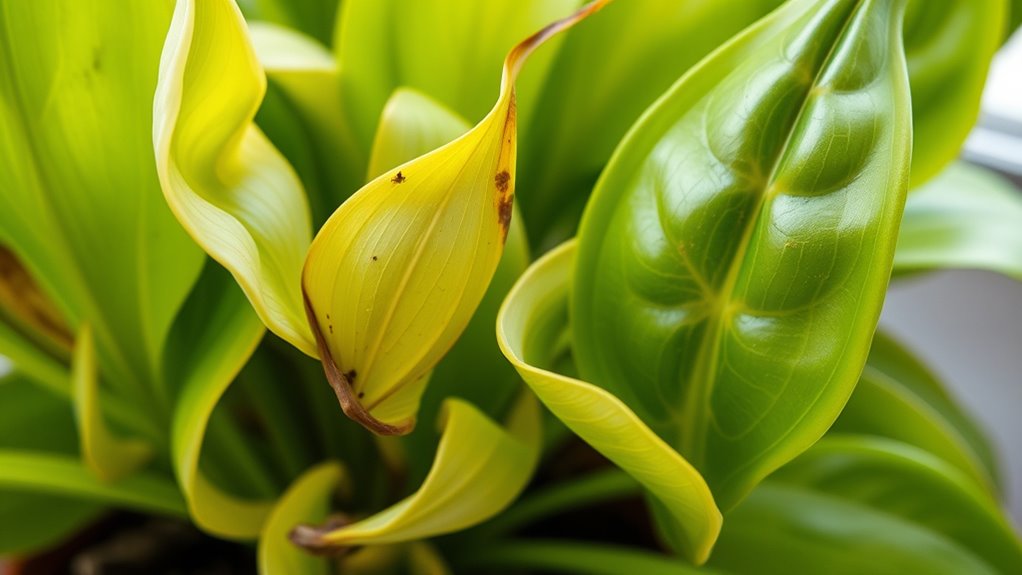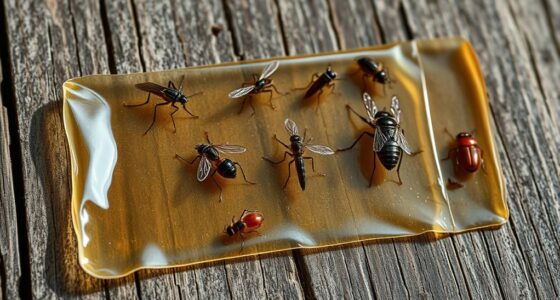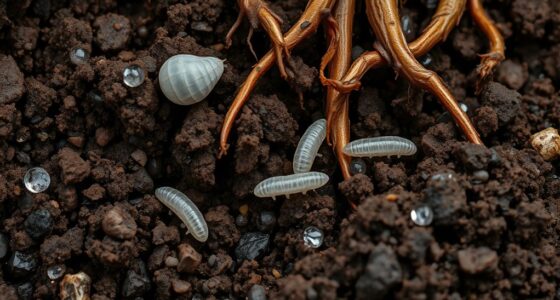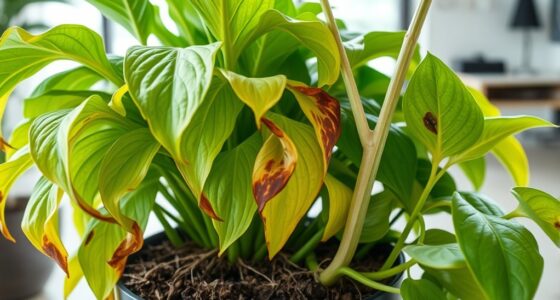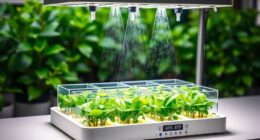If your plant looks unhealthy, watch for signs like wilting, yellowing, or brittle leaves, which can mean underwatering or overwatering. Sticky residue or tiny pests point to infestations, while fuzzy patches or black spots suggest disease. Check soil moisture levels—dry indicates dryness, soggy hints at overwatering. Discoloration or spots may signal pests or fungal issues. Spotting these signs helps you pinpoint the problem—continue exploring to learn how to fix it.
Key Takeaways
- Observe overall plant appearance: wilting, yellowing, or browning leaves indicate watering issues, pests, or diseases.
- Check soil moisture: soggy soil suggests overwatering; dry soil signals underwatering.
- Look for pests: tiny insects, sticky residue, or fuzzy patches reveal infestations.
- Inspect for fungal signs: mold, black spots, or mildew point to fungal infections.
- Note leaf changes: curling, spots, or discoloration can be symptoms of pests, nutrient deficiencies, or environmental stress.
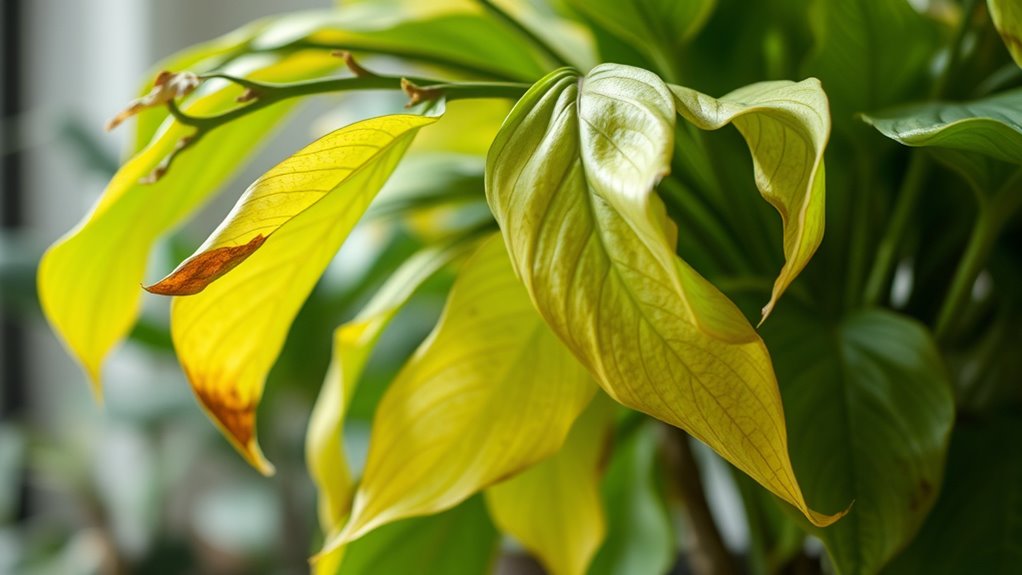
If your plant isn’t thriving, it’s easy to feel frustrated and unsure of what’s wrong. The first step is to observe its overall appearance and behavior carefully. Often, signs of trouble stem from watering issues or pests and diseases. Overwatering can cause leaves to yellow and roots to rot, while underwatering typically leads to wilting and dry, brittle foliage. Check the soil moisture by sticking your finger about an inch deep; if it feels soggy, you’re likely overwatering. Conversely, if it’s bone dry, your plant needs more water. Adjust your watering schedule accordingly, ensuring that you’re not drowning the roots or leaving the soil parched.
Observe your plant’s appearance carefully to identify watering issues or pests and diseases.
Pests and diseases are common culprits behind many plant problems. Tiny insects like aphids, spider mites, or mealybugs can sap nutrients from your plant, leading to stunted growth, sticky residue, or visible pests on the leaves and stems. Look for discolored spots, holes, or fuzzy patches, which often signal an infestation. If you spot pests, isolate the plant and take action—wiping leaves with a damp cloth, applying insecticidal soap, or introducing natural predators like ladybugs can help control the problem.
Diseases, on the other hand, often manifest as mold, mildew, or black spots on leaves and stems. These issues usually develop in overly humid environments or when airflow is poor. Removing affected foliage and improving ventilation can markedly reduce the spread. Avoid overhead watering, which creates a moist environment conducive to fungal growth, and consider using fungicides if necessary.
Your plant’s appearance can also reveal underlying issues. Wilting leaves, for example, might be a sign of root rot caused by watering problems, or they could indicate a pest infestation or disease. Pale or yellowing leaves might suggest nutrient deficiencies or improper lighting. Reddish or brown spots can point to fungal infections, while curling or distorted leaves often result from pests or environmental stress. Additionally, using a home theatre projector with proper contrast ratio can help you better assess subtle color changes and spotting issues on your plant’s leaves.
Frequently Asked Questions
How Often Should I Water My Plant?
You should water your plant based on its specific needs, but generally, watering frequency depends on soil moisture. Check the top inch of soil; if it feels dry, it’s time to water. Avoid overwatering, which can lead to root rot. Adjust your watering schedule seasonally, allowing the soil to dry out slightly between waterings. Remember, consistent soil moisture helps your plant stay healthy and vibrant.
What Is the Ideal Sunlight for My Plant?
You want to know the ideal sunlight for your plant. Check its light exposure needs and sun requirements, which vary by species. Some plants thrive in direct sunlight, while others prefer indirect or partial shade. Observe how your plant responds to different light levels, and modify its placement accordingly. Providing the right amount of sun ensures healthy growth and vibrant leaves, so tailor its light exposure to meet its specific needs.
How Do I Prevent Pests From Damaging My Plant?
To prevent pests from damaging your plant, start with pest identification to understand what you’re dealing with. Keep an eye out for signs like holes or sticky residue. Use natural repellents such as neem oil or insecticidal soap regularly. make certain your plant stays healthy with proper watering and sunlight, making it less attractive to pests. Consistent monitoring and early intervention are key to keeping pests at bay and protecting your plant’s health.
When Should I Fertilize My Houseplants?
You might think you should fertilize your houseplants constantly, but that’s not true. Instead, follow a regular fertilizer schedule, usually every 4-6 weeks during the growing season. This helps prevent nutrient deficiency and keeps your plants healthy. During winter, cut back. Over-fertilizing can harm your plant, so observe its growth and adjust accordingly. Proper timing guarantees your plant gets the nutrients it needs without risking damage.
What Soil Type Is Best for My Specific Plant?
When choosing soil for your plant, you want to think about its specific needs. Look for soil that offers good soil drainage to prevent root rot and maintains the right soil pH, which varies among plants. For example, acid-loving plants prefer slightly acidic soil, while others thrive in neutral or alkaline conditions. Knowing your plant’s preferences helps you select the best soil type for healthy growth and vibrant foliage.
Conclusion
By paying close attention to your plant’s signals, you can prevent minor issues from turning into catastrophic plant disasters. Recognizing the ten signs we’ve covered is like having a botanical sixth sense—saving your plant from certain doom. With a little care and keen observation, you’ll keep your green companion thriving and beautiful, turning your home into a lush paradise. Remember, your plant’s health is a reflection of your own nurturing spirit—so stay vigilant and love it well.
